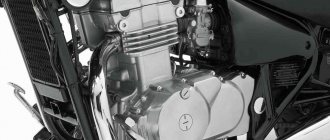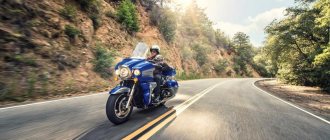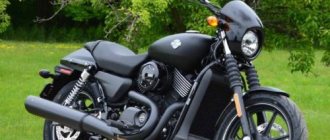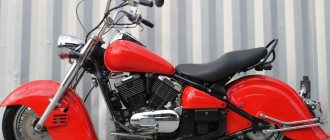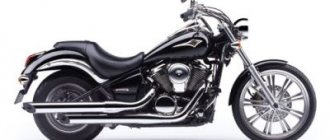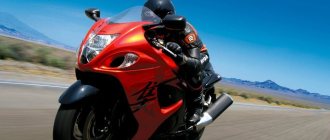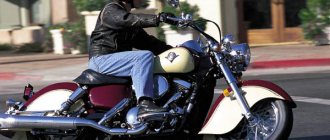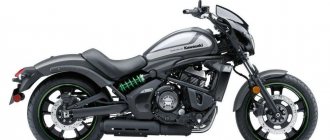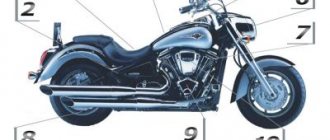It shines, roars and asks to go... Having gotten rid of the shortcomings of the EN 400, it is ready for new achievements and does not tolerate compromises. We are, of course, talking about the Kawasaki VN 400 Vulcan from the same legendary concern! This time Kawasaki decided to do something really impressive...
The motorcycle is a logical continuation of the EN of the same number, and outwardly even someone can confuse them. But not an experienced biker! Even the exterior itself declares: this is a beast of a completely different breed, and it has many times more ambitions!
Engine
The first distinguishing feature of the model is its engine. Four-stroke and two-cylinder, it is, however, no longer in-line, but V-shaped. Its working volume is almost 400 cubic centimeters (399). This circumstance, combined with a 15-liter tank, makes the motorcycle suitable for lovers of long trips.
The maximum speed is lower than that of the four hundredth “ancestor”, and reaches only 140 kilometers per hour, but this is more than compensated for by the increased traction! Such motorcycles don’t need too much speed; that’s what sports bikes are for.
At its peak, the torque reaches 32 nanometers, and the rpm is 4500. The highest power is 33 horsepower, the rpm is 8500.
Owner reviews
I drove the Vulcan for four years, I changed it only because my back began to hurt with age from long trips. I had to switch to a tourenduro, but I wouldn’t have sold it... Every year, consistently from Moscow to the sea, the maximum mileage per season was 22k, in just 4 years I covered almost 60k. During the entire period of repairs, the only repairs were replacement of the clutch, bearings (virtually in a circle) and minor wiring repairs. Anton, Moscow.
I fell in love with this bike from the photo and ordered it from Japan. When I arrived, there was no limit to my delight, but I was quickly disappointed. I used to drive a Dragstar 400, I thought that one and a half liters could not help but like it - but no... It’s heavy, it constantly tries to fall in turns at low speed, the dynamics are sluggish. Maybe, of course, I received a damaged copy, but in any case it didn’t work. I sold it two months later and bought a VTX1300 - heaven and earth. Grigory, Rostov-on-Don.
For the money, it’s a normal piece of hardware, although Kawasaki’s habit of saving on various little things like the quality of plastic and chrome, of course, is simply killing. But it costs less than its analogues, the engine, gearbox and chassis are all good, so it’s an option, especially if you don’t have a lot of money, but you want “one and a half liters!!!” True, he doesn’t go by one and a half, the same Shadow 1100 leaves him, but it’s also fifty kg lighter. Nikolay, Krasnoyarsk.
Dimensions and weight
The motorcycle is quite large. Even in width it is 1005 millimeters. Its length reaches all of 2490 millimeters, and its height is 1125. The saddle height of the model is 760 millimeters, and the wheelbase reaches 1615. 248 kilograms allow the Kawasaki VN 400 to be classified as a heavyweight classic, making it not the most convenient option for short people with a non-athletic constitution.
FAQ
- Are spare parts between different modifications of Vulcans compatible or not? Depends on the specific modification and year of manufacture. There are almost no differences in engine and transmission between bikes of the same generation, with the exception of the Mean Streak version.
- Is it true that it begins to eat up oil after 50-60 thousand mileage? Partly true. But many cruisers suffer from an oily appetite, which does not prevent them from putting hundreds of thousands of kilometers on their wheels.
- Is it possible to install a 5-speed gearbox on a bike that originally had a 4-speed gearbox? No, otherwise you will have to change a bunch of other parts. It will be cheaper to change the motorcycle.
Chassis and brakes
The frame is a steel tubular body, which is designed in the best traditions of classic design. This motorcycle is not as modest as the EN 500 Vulcan. No, with all his appearance he “screams” about his own originality and power. It may seem that its appearance challenges those who are considering a purchase.
The front suspension is a telescopic fork increased to 41 millimeters, with the same travel as the EN 400 – 15 millimeters. The rear suspension has only a monoshock absorber, and it is of pendulum type. The stroke of the latter is 100 millimeters. The size of motorcycle wheels is within the framework of classical traditions. The appearance of the discs can be a source of pride for this Vulcan: there are few places where you can find such a precise and stylized design.
The steering wheel gives control and confidence. It is not too big, but allows you to sufficiently feel and control the car. The mirrors have the shape of an irregular quadrangle with an extension from the driver. A sort of middle option between modernism and old school.
The car's brakes correspond to its capabilities in terms of speed and traction: at the front there is a 300 mm disc, accompanied by a two-piston caliper; well, the rear is almost the same, only the disc diameter is 270 millimeters.
Known design issues with the Kawasaki Vulcan VN400
Despite all the simplicity and reliability, you need to take into account the age of individual motorcycles. Wire insulation and contacts do not last forever, the first cracks and collapses, the second oxidizes, and if the playful hands of a “nosy electrician” previously got into it, then sometimes it’s easier to completely change the entire harness than to deal with endless “twists”, unwinding kilometers of electrical tape.
Among the shortcomings of the Kawasaki Vulcan VN400 is the monoshock absorber, the rigidity of which is not enough even for a driver with a slightly above average weight, but usually this problem has already been solved by the previous owner, unless of course it was a fifty-kilogram Japanese.
If you find fault, then weak brakes also come under attack. And if in the Drifter version, due to the rear brake disc, the motorcycle brakes quite confidently, then in versions with a rear drum brake, we can say that there is no rear brake. On the other hand, the capabilities of the 400 cc engine are very limited, so you first need to accelerate before braking. To be objective, the lack of brakes is felt at speeds above 70-80 km/h when sudden braking is necessary.
History of changes
The model has undergone a number of modifications that have benefited it. Here's a little history of the big motorcycle:
- 1995 – the first generation appeared;
- 1996 – Vulcan Classic version released;
- 1998 – Classic does not enter the market;
- 1999 – return of the Classic and appearance of the Drifter;
- 2003 – end of production of the model and modifications.
For one reason or another, the Kawasaki VN 400 Vulcan could not stay afloat as long as the EN 500 did. Nevertheless, the model was a great success, and many connoisseurs of the concern’s products and the classic “steel horse” will be happy to buy this wonderful bike, if they come across such a proposal.
Development of Kawasaki Vulcan VN400
The motorcycle is presented in 4 variants, although in fact there are 3 of them. Their designation is as follows: the basic version is designated by the letters A and B after VN400 (produced from 1995 to 1999); the letter C denotes the “Classic” version (produced from 1996 to 2003 with a break in 1998); the designation with the letter D is for the “Drifter” modification (produced from 1999 to 2002).
Visually distinguishing modifications from each other is as easy as shelling pears. The Classic differs from the basic version by having a 16-inch front wheel instead of a 21-inch one. The version with the designation “Drifter” had a disc rear brake instead of a drum rear brake, a 2-in-1 exhaust, you can also focus on the absence of a passenger seat and wide fenders. The modifications themselves did not undergo significant changes during the production process.
Specifications:
| Model | Kawasaki VN400 Vulcan |
| Motorcycle type | cruiser |
| Year of issue | 1995-2003 |
| Frame | steel tubular |
| engine's type | 2-cylinder, 4-stroke, V-shaped |
| Working volume | 399 cc cm. |
| Bore/Stroke | 62.0 x 66.2 mm |
| Compression ratio | 9.8:1 |
| Cooling | liquid |
| Number of valves per cylinder | SOHC, 4 valves per cylinder |
| Fuel supply system | carburetor, 1x Keihin CVK32 |
| Ignition type | transistor |
| Maximum power | 33.0 hp (24 kW) at 8500 rpm |
| Maximum torque | 32.0 Nm (3.3 kgf*m) at 4500 rpm |
| Transmission | 5-speed |
| type of drive | chain |
| Front tire size | 80/90-21 48H – VN400A/B 130/90-16 67H – VN400C, VN400D |
| Rear tire size | 140/90-16 71H |
| Front brakes | 1 disc, 300 mm, 1-piston caliper – VN400A/B 1 disc, 300 mm, 2-piston caliper – VN400C 1 disc, 300 mm, 2-piston caliper – VN400D |
| Rear brakes | Drum, 180 mm – VN400A/B/C 1 disc, 270 mm, 2-piston caliper – VN400D |
| Front suspension | 41 mm telescopic fork, travel - 150 mm |
| Rear suspension | pendulum Uni-trak with monoshock absorber (adjustable preload), stroke - 100 mm |
| Motorcycle length | 2360 mm – VN400A/B 2375 mm – VN400C 2490 mm – VN400D |
| Motorcycle width | 825 mm – VN400A/B 930 mm – VN400C 1005 mm – VN400D |
| Motorcycle height | 1170 mm – VN400A/B 1130 mm – VN400C 1125 mm – VN400D |
| Wheelbase | 1625 mm – VN400A/B 1600 mm – VN400C 1615 mm – VN400D |
| Seat height | 710 mm – VN400A/B 700 mm – VN400C 760 mm – VN400D |
| Acceleration to 100 km/h | |
| Maximum speed | 140 km/h |
| Gas tank capacity | 15.0 l (including reserve - 3 l) - VN400A/B 14.0 l - VN400C, VN400D |
| Motorcycle weight (dry) | 225 kg – VN400A/B 234 kg – VN400C 248 kg – VN400D |
Modifications
During the production of the motorcycle there were three modifications.
- Kawasaki Vulcan VN400 A and Kawasaki Vulcan 400 B. Production of the model began with them. They existed on the assembly line for three years. 1995-1998. The first model had a belt drive, the second - a chain. A limited batch of the first ones was sent to America - but were not successful. The second model was officially supposed to remain only in Japan and in domestic markets was also designated as Vulcan II. The main difference between both versions is the Harley-Davidson Softail style design.
- Kawasaki Vulcan VN400 C (Classic). Production began in 1996. I got the same wheels 16/16 versus 21/18 for the first versions. Extended wings, like a road worker’s + a small mudguard. Black color (except for engine covers and exhaust pipes.). Produced until 2003. This and the next model already have a 14 liter tank.
- Kawasaki Vulcan VN400 D (Drifter).
If the first versions borrowed design from Harley-Davidson, this one took advantage of the developments of Indian (not to be confused with the country of the same name - the Indian Motocycle Manufacturing Company is located in the USA). Recessed fenders now cover the sides of the wheels, two muffler banks have been combined into one, and the saddle has been changed. Began in 1999, produced until production was completed. Vulcan VN400 Drifter is an Indian-style version of the motorcycle.
It is worth noting that neither the letters in the name, nor the more odious name of the third model, carried any hidden meaning.
Competitors
The model turned out to be so unusual that representatives of other American brands could not imagine an equivalent one. However, not wanting to give the entire pie (market) to Kawasaki, they offered a couple of analogues at once.
Honda
Honda Steed 400 is a light cruiser designed for American needs.
Honda offered its developments Honda Steed 400 and Honda Shadow 400.
- The first featured three valves per cylinder.
- Two carburetors.
- 10 liter tank, with a consumption of 5 liters.
- Production started in 1988.
- Closed in 2001.
The model started in 1997 and ended in 2016.
Yamaha
Yamaha XV400 Virago - a cruiser intended for the domestic market.
Yamaha's answer was the Yamaha XV400 Virago and Yamaha XVS400 Drag Star.
Interestingly, according to the developer documentation, the second is the successor to the first. Both bikes differed from the Kawasaki in that they were air cooled and had a pair (2) valves per cylinder. Both had a driveshaft, the rear shock absorber was also different. Virago had a pair of springs (versus one), the star had a rear progression. The gas tank of the first was 13 (consumption 6) liters, the second - 15 liters (consumption 3) liters. The first one started in 1987, closed in 1994, the second one opened in 1996 and existed until 2022.
Suzuki
Suzuki Intruder VS400 is a rather rare representative of serial choppers.
Suzuki did not lag behind either. For the first version, he proposed the Suzuki Intruder VS400, and for the rest, the Suzuki Intruder VL400 Classic.
- The VS400 boasted a driveshaft, a carburetor hub, and a pair of springs on the rear shock absorber. Had a 12 liter tank, consumed 4 liters. The production opened in 1994 and closed in 1996.
- The VL400 also received a driveshaft. The second generation versions were equipped with an injector. The tank is 17 liters, with a consumption of 3 liters. It is the successor to the previous model. Opened in 2001, closed in 2020.
Flaws
The owners do not find any particular disadvantages in their “iron horse”, with the exception of one, which consists of several. This is a mono-shock absorber - rear suspension .
- The main disadvantage that everyone faces is attaching it to the frame. Since it is located below the frame itself, when driving into a garage or a small hill it is easy to “sit down” on it. And since they saved on metal, the fastening instantly flies off. And this is not a warranty repair (especially if you remember that the bike can now only be bought on the secondary market).
The rear shock absorber is the weakest point.
The monoshock absorber mount is located below the frame.
- “Powerful” bikers faced the second disadvantage. Perhaps in Japan it didn’t feel that way, but it’s better not to drive on Russian roads when they’re loaded. One guy weighing 90 kg . If two sit down, a breakdown is guaranteed.
But they also note the carrying capacity. Although there is space under the case, it’s not worth putting anything heavier than a motorcycle helmet there. The total weight indicated in the specifications is 300 kg. Of which 190 are the motorcycle itself. Two passengers of average build are already an overload. You can leave, but it will be faster on a scooter.
and dignity
Perhaps the most important advantage of the bike is its high reliability.
There are also advantages:
- Low fuel consumption.
- Well managed.
- Maneuverability.
- Easy to maintain.
- reliability.
- small Harley.
And they also note the low center of gravity and weight . Whether this is a plus or a minus, everyone decides in their own way. Due to the low center, it holds the track well. Large weight - maintains direction in crosswinds.
Peculiarities
With the exception of 1 carburetor operating on a pair of cylinders, users do not note any other features.
True, there are several jambs when servicing:
- When adding antifreeze, you will have to climb into the gas tank or remove the speedometer. Both plugs are closed by one hatch.
The speedometer is located directly on the fuel tank, with warning lights below.
- When replacing the spark plug on the first cylinder, remove the gas tank. To replace the second one, remove the saddle.
The fuel tank practically lies on the cylinders; the most that can be done is to remove the spark plug cap.
Some call it a noisy gearbox. But as the developers say, this is not a bug, this is a feature . Boxes on any motorcycle of the brand are characterized by excessive noise.
Tire selection
Both of these motorcycles are built from road bikes and are not choppers in the generally accepted sense. And they got the tires from road donors, and their size too. It won’t be easy to find something classic old-school cruiser in 17” sizes, so I don’t even recommend thinking about it. Buy something sporty and touring and be happy.
For a Honda with a 17” front wheel, the choice is wide. Not so long ago, 120/70 + 160/60 was the industry standard for 600 naked bikes and supermotos. There are no difficulties with the choice. If the financial issue is not pressing, then Michelin Road 5 or the previous model Pilot Road 4 and 3, Pirelli Angel GT and ST, Metzeler Roadtec 01, Dunlop Roadsmart III
If you are pressed, then pay attention to Shinko Verge 011 or budget series of famous manufacturers: Michelin Pilot Street Radial, Pirelli Diablo Strada, Metzeler Roadtec Z 6. If you want to add a little scrambler notes to the appearance of the motorcycle, then you can look at slightly toothy tires like Pirelli MT 60 RS Corsa or Heidenau K 73 Superrain
You can also install slicks, but it will look stupid.
The Kawasaki is a little more difficult because it has an 18" front wheel. This slightly narrows the list of models available as a set. Michelin will be available Pilot Road 3 and 4, but there will be no “fifth”, or Metzeler Roadtec Z 6-Z 8 and 01, Pirelli Angel GT and ST, Dunlop Roadsmart III and the same Shinko 011. Of the “something” options “more toothy” is only the Pirelli MT 60 RS Corsa.
Remember that any modern sports-touring tires exceed the grip capabilities, both power and geometric, of these motorcycles. Don’t get hung up on searching for just one brand – there are a lot of good tires in the world, and you can always find something tenacious, long-lived and inexpensive. You just need to know what and where to look.
